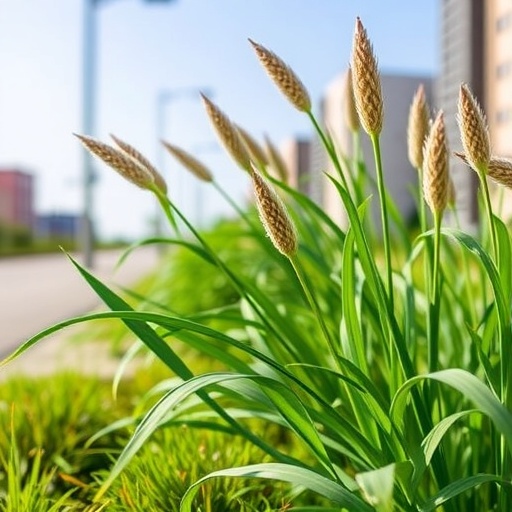In an era where environmental sustainability is becoming increasingly crucial, researchers are exploring innovative ways to repurpose green spaces into valuable resources. A recent study by Chopda, R., de Souza, M.F., and Robles-Aguilar, A. focuses on the biorefinement of roadside verges, which are often underutilized and frequently overlooked. Their work investigates not only the generation of biogas from grass sourced from these roadside areas but also assesses the viability of grass digestates as nutrient sources for urban ornamentals.
Roadside verges are the strips of land that line roads and highways, usually covered in grass and other flora. Surprisingly, these areas are often rich in organic material, presenting a unique opportunity for biogas generation through anaerobic digestion. By transforming organic waste into biogas, which can be used as a renewable energy source, we can tackle two pressing challenges at once: waste management and energy production. This research takes on a significant role in expanding our understanding of how to integrate urban landscapes into sustainable practices.
The primary goal of the study is to evaluate the efficiency of biogas production from roadside grass, a potentially abundant yet underutilized feedstock. Utilizing anaerobic digestion, the research team aims to determine the yield of biogas produced from grass harvested from these verges. Anaerobic digestion is a process whereby microorganisms break down organic matter in the absence of oxygen, generating methane-rich biogas as a byproduct. This method has been used successfully in various agricultural applications and offers a promising path for urban waste management.
Additionally, the study digs deeper into the residual materials left after biogas extraction, known as digestates. Grass digestates contain valuable nutrients that can benefit urban ornamental plants. Assessing their potential as fertilizers, the researchers aim to determine the nutrient composition of these digestates and their effectiveness in promoting plant growth. This dual approach not only focuses on energy generation but also on converting waste into useful byproducts that can enhance urban horticulture.
The researchers meticulously conducted experiments to analyze several variables, including the biomass yield of roadside grass, the efficiency of biogas production, and the nutrient profiles of the resulting digestates. By employing rigorous scientific methods, they ensured a comprehensive understanding of the process, making it easier to replicate and apply in real-world settings. The data collected will inform stakeholders, urban planners, and policymakers about the potential benefits of integrating biogas production into municipal waste management strategies.
One of the standout findings of the study is the remarkable yield of biogas from roadside grass. When compared to traditional agricultural feedstocks, such as corn or soy, roadside grasses demonstrate a comparable, if not superior, biogas production rate. This discovery opens the door to utilizing so-called “waste” areas as renewable energy sources, providing a sustainable alternative to fossil fuels and contributing to the larger energy transition goals.
Moreover, the nutrient-rich digestates produced from the biogas process hold promise for enhancing urban green spaces. Urban ornamentals, which include a variety of plants used primarily for decorative purposes in cities, often require balanced nutrients for optimal growth. Utilizing digestates as organic fertilizers may not only promote plant health but also reduce dependence on synthetic fertilizers, aligning with environmental protection goals.
A critical aspect of the research is understanding the ecological impacts of converting roadside verges into biogas production zones. This involves assessing the biodiversity of plants and wildlife that inhabit these spaces. The researchers emphasize that such transformations should be approached sustainably, ensuring the preservation of local ecosystems while maximizing energy generation and resource recovery.
The study also reflects on the economic implications of utilizing roadside verges for biogas production. By adopting biorefineries in urban settings, cities could potentially alleviate waste disposal costs and create jobs related to biogas production and plant care. These economic benefits, coupled with environmental incentives, make biorefining roadside verges an attractive proposition for cities looking to enhance their sustainability initiatives.
In conclusion, the research conducted by Chopda et al. offers a multifaceted perspective on the underutilized potential of roadside verges. By generating biogas and assessing the nutrient value of grass digestates, the study presents a compelling case for integrating waste management, renewable energy, and urban agriculture into city planning. This innovative approach highlights the importance of reimagining traditional agricultural practices and urban landscapes to build a more sustainable future.
In essence, the findings not only contribute to the field of renewable energy but also inspire a review of how green spaces can play a pivotal role in urban development. By harnessing the benefits of biogas from roadside grass and utilizing the resulting digestates for ornamental horticulture, cities can turn their ecological footprints into platforms for sustainability.
Subject of Research: Biorefining roadside verges for biogas generation and nutrient assessment of grass digestates.
Article Title: Biorefining Roadside Verges: Biogas Generation and Assessment of Grass Digestates as Nutrient Sources for Urban Ornamentals.
Article References:
Chopda, R., de Souza, M.F., Robles-Aguilar, A. et al. Biorefining Roadside Verges: Biogas Generation and Assessment of Grass Digestates as Nutrient Sources for Urban Ornamentals.
Waste Biomass Valor (2025). https://doi.org/10.1007/s12649-025-03274-4
Image Credits: AI Generated
DOI: 10.1007/s12649-025-03274-4
Keywords: Biorefining, Biogas, Roadside Verges, Urban Sustainability, Digestates, Renewable Energy, Urban Horticulture.




